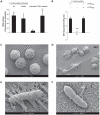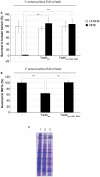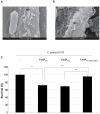Oligomeric coiled-coil adhesin YadA is a double-edged sword - PubMed (original) (raw)
Oligomeric coiled-coil adhesin YadA is a double-edged sword
Salome Casutt-Meyer et al. PLoS One. 2010.
Abstract
Yersinia adhesin A (YadA) is an essential virulence factor for the food-borne pathogens Yersinia enterocolitica and Yersinia pseudotuberculosis. Surprisingly, it is a pseudogene in Yersinia pestis. Even more intriguing, the introduction of a functional yadA gene in Y. pestis EV76 was shown to correlate with a decrease in virulence in a mouse model. Here, we report that wild type (wt) Y. enterocolitica E40, as well as YadA-deprived E40 induced the synthesis of neutrophil extracellular traps (NETs) upon contact with neutrophils, but only YadA-expressing Y. enterocolitica adhered to NETs and were killed. As binding seemed to be a prerequisite for killing, we searched for YadA-binding substrates and detected the presence of collagen within NETs. E40 bacteria expressing V98D,N99A mutant YadA with a severely reduced ability to bind collagen were found to be more resistant to killing, suggesting that collagen binding contributes significantly to sensitivity to NETs. Wt Y. pestis EV76 were resistant to killing by NETs, while recombinant EV76 expressing YadA from either Y. pseudotuberculosis or Y. enterocolitica were sensitive to killing by NETs, outlining the importance of YadA for susceptibility to NET-dependent killing. Recombinant EV76 endowed with YadA from Y. enterocolitica were also less virulent for the mouse than wt EV76, as shown before. In addition, EV76 carrying wt YadA were less virulent for the mouse than EV76 expressing YadA(V₉₈D,N₉₉A). The observation that YadA makes Yersinia sensitive to NETs provides an explanation as for why evolution selected for the inactivation of yadA in the flea-borne Y. pestis and clarifies an old enigma. Since YadA imposes the same cost to the food-borne Yersinia but was nevertheless conserved by evolution, this observation also illustrates the duality of some virulence functions.
Conflict of interest statement
Competing Interests: The authors have declared that no competing interests exist.
Figures
Figure 1. YadA renders Y. enterocolitica sensitive to NET-dependent killing.
(A) Y. enterocolitica induces DNA release upon infection of PMNs. PMNs were infected for 120 min with Y. enterocolitica E40 (wt or ΔYadA) at an moi of 1. DNA release was quantified by Sytox staining. Untreated PMNs were used as negative control and NET formation was induced by PMA as positive control. Mean values from three or more experiments and standard deviation are shown including statistical significance in comparison to untreated PMNs with ** p<0.01 and * p<0.05 using one-way ANOVA. (B) % of Y. enterocolitica E40 (wt, ΔYadA and ΔYadA endowed with pSAM16 encoding YadAΨtb) killed by PMA-triggered NETs (120 min infection at a moi of 1). Phagocytosis was prevented by the addition of Cytochalasin D (CytD). Mean values from three or more experiments and standard deviation are shown. Statistical significance is shown in comparison to Y. enterocolitica wt with *** p<0.001 using one-way ANOVA. (C) Scanning electron micrograph (SEM) of untreated human PMNs and (D) of NETs formed by human PMNs treated with PMA. (E) SEM of Y. enterocolitica E40 wt bacteria (expressing YadA) trapped in NETs after 120 min infection at an moi of 1. (F) Y. enterocolitica E40 ΔYadA bacteria induce NET formation but are not trapped (same conditions as in A) (SEM). NET structure covers the whole bottom.
Figure 2. NETs contain collagen.
(A) Untreated PMNs. DNA (blue) and collagen (green) visualized by immunofluorescence. (B) Same staining after the PMNs have been infected with Y. enterocolitica E40 for 120 min at an moi of 1. Smears represent NETs. 60 x magnification, DNA (blue), collagen (green) and brightfield.
Figure 3. Collagen binding contributes to the sensitivity of Y. enterocolitica to NETs.
(A) Mutation of the collagen binding motif has no effect on serum resistance. % survival of Y. enterocolitica E40 ΔYadA, E40 ΔYadA (pFR1) expressing YadAent, or E40 ΔYadA (pFR2) expressing YadAentV98D,N99A, incubated for 1 hour in the presence of 10% normal human serum (NHS) or heat-inactivated human serum (HI NHS). (B) % Survival to NET-dependent killing of Y. enterocolitica E40 ΔYadA, E40 ΔYadA (pMA1) expressing YadAent, or E40 ΔYadA (pSAM23) expressing YadAentV98D,N99A. (C) YadAentV98D,N99A forms trimers. SDS PAGE analysis of total cells from Y. enterocolitica E40 ΔYadA, E40 ΔYadA (pFR1) expressing YadAent, or E40 ΔYadA (pFR2) expressing YadAentV98D,N99A. The band corresponding to trimeric YadA is boxed.
Figure 4. YadA renders Y. pestis EV76 sensitive to NET-dependent killing.
(A) Y. pestis EV76 wt bacteria (do not express YadA) induce NET formation but are not trapped (SEM, same conditions as in Fig 1). (B) Y. pestis EV76(pMA1) expressing YadAent trapped in NETs (same conditions as in A). (C) % of survival of Y. pestis EV76 wt, EV76(pMA1) endowed with YadAent, EV76(pSAM23) endowed with YadAentV98D,N99A or EV76(pSAM16) endowed with YadAΨtb in the presence of PMA-triggered NETs. Phagocytosis was prevented by the addition of CytD. Mean values from three or more experiments and standard deviation are shown. Statistical significance is shown with ** p<0.01 and *** p<0.001 using one-way ANOVA.
Figure 5. YadA drastically reduces the virulence of Y. pestis EV76 for mice.
Collagen-binding contributes to this effect. Iron loaded Balb/c mice were infected i.p. with 5×103 CFU of Y. pestis EV76(pACYC184) (empty vector), EV76(pFR1) (YadAent) or EV76(pFR2) (YadAentV98D,N99A). (A) Survival, (B) weight loss, and (C) bacterial load in spleens of mice on day 7. Data are represented as mean ± standard deviation for weight loss and median for CFU/g of at least 7 mice per group in two independent experiments. Significant differences are indicated by * p<0.05, ** p<0.01, and *** p<0.001.
Similar articles
- Yersinia adhesin A (YadA)--beauty & beast.
Mühlenkamp M, Oberhettinger P, Leo JC, Linke D, Schütz MS. Mühlenkamp M, et al. Int J Med Microbiol. 2015 Feb;305(2):252-8. doi: 10.1016/j.ijmm.2014.12.008. Epub 2014 Dec 24. Int J Med Microbiol. 2015. PMID: 25604505 Review. - Role of YadA-mediated collagen binding in arthritogenicity of Yersinia enterocolitica serotype O:8: experimental studies with rats.
Gripenberg-Lerche C, Skurnik M, Toivanen P. Gripenberg-Lerche C, et al. Infect Immun. 1995 Aug;63(8):3222-6. doi: 10.1128/iai.63.8.3222-3226.1995. Infect Immun. 1995. PMID: 7622253 Free PMC article. - YadA, the multifaceted Yersinia adhesin.
El Tahir Y, Skurnik M. El Tahir Y, et al. Int J Med Microbiol. 2001 Aug;291(3):209-18. doi: 10.1078/1438-4221-00119. Int J Med Microbiol. 2001. PMID: 11554561 Review. - Identification of a domain in Yersinia virulence factor YadA that is crucial for extracellular matrix-specific cell adhesion and uptake.
Heise T, Dersch P. Heise T, et al. Proc Natl Acad Sci U S A. 2006 Feb 28;103(9):3375-80. doi: 10.1073/pnas.0507749103. Epub 2006 Feb 17. Proc Natl Acad Sci U S A. 2006. PMID: 16488979 Free PMC article.
Cited by
- In Vivo Imaging of Neutrophil Extracellular Traps (NETs): Visualization Methods and Outcomes.
Alasmari SZ. Alasmari SZ. Biomed Res Int. 2020 Feb 1;2020:4192745. doi: 10.1155/2020/4192745. eCollection 2020. Biomed Res Int. 2020. PMID: 32090090 Free PMC article. Review. - Exploring neutrophil extracellular traps: mechanisms of immune regulation and future therapeutic potential.
Gao F, Peng H, Gou R, Zhou Y, Ren S, Li F. Gao F, et al. Exp Hematol Oncol. 2025 May 29;14(1):80. doi: 10.1186/s40164-025-00670-3. Exp Hematol Oncol. 2025. PMID: 40442839 Free PMC article. Review. - Adh enhances Actinobacillus pleuropneumoniae pathogenicity by binding to OR5M11 and activating p38 which induces apoptosis of PAMs and IL-8 release.
Wang L, Qin W, Zhang J, Bao C, Zhang H, Che Y, Sun C, Gu J, Feng X, Du C, Han W, Richard PL, Lei L. Wang L, et al. Sci Rep. 2016 Apr 5;6:24058. doi: 10.1038/srep24058. Sci Rep. 2016. PMID: 27046446 Free PMC article. - Identifying Yersinia YopH-targeted signal transduction pathways that impair neutrophil responses during in vivo murine infection.
Rolán HG, Durand EA, Mecsas J. Rolán HG, et al. Cell Host Microbe. 2013 Sep 11;14(3):306-17. doi: 10.1016/j.chom.2013.08.013. Cell Host Microbe. 2013. PMID: 24034616 Free PMC article. - Distinct susceptibilities of corneal Pseudomonas aeruginosa clinical isolates to neutrophil extracellular trap-mediated immunity.
Shan Q, Dwyer M, Rahman S, Gadjeva M. Shan Q, et al. Infect Immun. 2014 Oct;82(10):4135-43. doi: 10.1128/IAI.02169-14. Epub 2014 Jul 21. Infect Immun. 2014. PMID: 25047845 Free PMC article.
References
- Pettersson J, Nordfelth R, Dubinina E, Bergman T, Gustafsson M, et al. Modulation of virulence factor expression by pathogen target cell contact. Science. 1996;273:1231–1233. - PubMed
- Mota LJ, Journet L, Sorg I, Agrain C, Cornelis GR. Bacterial injectisomes: needle length does matter. Science. 2005;307:1278. - PubMed
- Boyd AP, Grosdent N, Totemeyer S, Geuijen C, Bleves S, et al. Yersinia enterocolitica can deliver Yop proteins into a wide range of cell types: development of a delivery system for heterologous proteins. Eur J Cell Biol. 2000;79:659–671. - PubMed
Publication types
MeSH terms
Substances
LinkOut - more resources
Full Text Sources
Other Literature Sources
Research Materials
Miscellaneous




